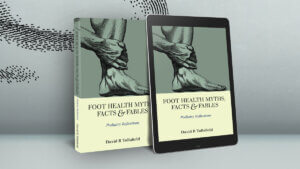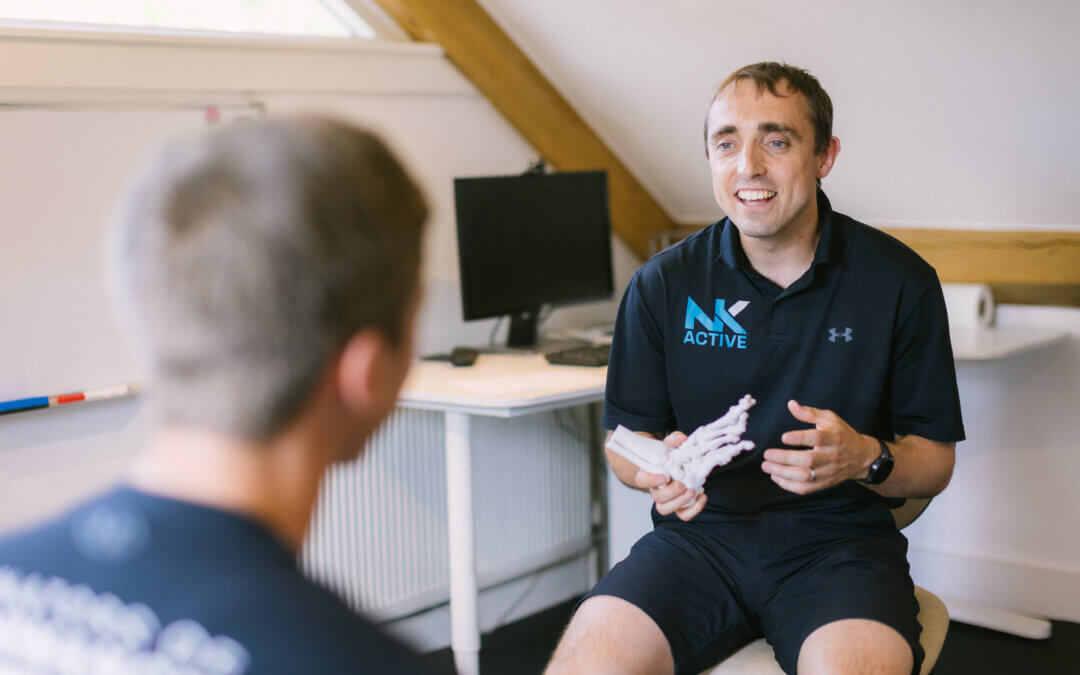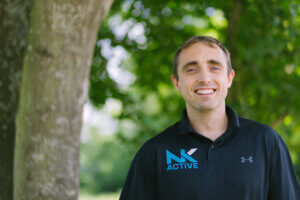Reflecting on a different approach to the MSK patient
As with many podiatrists, Nick Knight’s (feature image) initial career journey was not planned. Failing to become a physiotherapist, he turned to a local podiatrist to find out what podiatry’s role was. He entered university and was inspired to study podiatric medicine. In this article, he shares his thoughts and learning about rehabilitation, which has become an essential part of the podiatrist’s contribution to musculoskeletal work.

I knew that I always had an interest in musculoskeletal podiatric practice (MSK) and was fortunate enough to go to a university where the exposure happened weekly and the flame was ignited. I was then fortunate enough to be selected to work at the 2012 Paralympic games in London, where I found a mentor in Trevor Prior, just as I started my MSc. I was really starting to develop my MSK knowledge and was fortunate enough to work nearly full-time in an MSK role.
However, I felt something was missing in my practice armoury, and it was during my Master’s degree, having taken a physiotherapy module, rehabilitating lower quadrant injuries, that I realised I had a passion for injury rehabilitation – helping people get back to their activity. This was the one element missing from my undergraduate training. Of course, the programme is jampacked and not everything can be taught. I started reading about the rehabilitation of injuries, covering principles behind strength and conditioning and shadowing and sitting in with the rehabilitation specialists, which led me to learn how to implement this into clinical practice.
Developing a New Approach
We know that the physiology around improving muscular strength, power and endurance. We have a good understanding of the rehabilitation required for tendinopathy, and I will be completely open that at the beginning, I was very much a ‘numbers guy’ and focused on the quantitative data without paying much attention to the qualitative data. However, this changed during my research methods module on my Master’s programme through the team at the University of Southampton. Our patient-reported outcome measure scores for auditing our clinical process in the clinic were developed and we soon realised we were achieving good results. Currently, at the time of writing, our data shows us that around 97% of the time we will achieve the patient’s goals and that at 6, 12 and 18 months; those patients are still living an active lifestyle. I started looking at some of the data around the comments that patients experienced during their treatment journey, and what it meant to be able to do the activities that they wanted to do.
Pain is not always the prime motivator in sports
One of the immediate learning points that becomes obvious in healthcare is that we are sometimes guilty of assuming the patient’s desired outcome without asking them. For example, pain is not always the primary motivator, while being able to complete their activity regularly is the real goal. They don’t mind pain as long as it does not stop them from doing what they want.
Consistency
I can reflect on a common question from students as people start to shadow me. “Nick, what exercise do you give for this?” I realised that this is not the primary question we should be asking, for, given the majority of pathologies, numerous exercises can be applied for the same outcome. This approach comes down to knowing your anatomy and the function of the structure you are trying to work on. We know, for example, when dealing with the Achilles tendon, it is essential to retain the strength in the soleus muscle. We can apply nonsurgical management for tendinopathy but improvement does not come if the patient fails to adhere to the programme. They are part of this “emotional buy-in”. While it is easy to rehabilitate the infrastructure, we cannot exclude the brain’s human (emotional) side attached to that structure. To avoid predictable unreliability, patients require a different rehabilitation journey. We need a consistent approach and so a helpful acronym C-O-N-S-I-S-T-E-N-C-Y is recommended.
Commitment
“Without commitment, you will never start, but more importantly, without consistency, you never finish. It’s not easy” – Denzel Washington. To outline the commitment required by the patient to go through the rehabilitation journey, and for any reason, if they are not ready or cannot commit, we can always ask the question, ‘is now the best time to embark on this journey?’
Overcome barriers
We all have barriers, which is probably one of the most common reasons that everyone’s journey is different. It may be that someone is very time-poor; they may not have access to a gym. There may be other health conditions that need to be considered, such as financial barriers or fears and beliefs from reading something on the Internet; these will have to be managed and overcome before embarking on a rehabilitation journey.
An example of this with my own personal fitness and exercise is during the lockdown and having two very young children at home and my wife, who also works in the healthcare world, I found it was becoming increasingly difficult to fit any cardiovascular exercise in after 18:30. My main barrier was time and the fact that I had to be home to look after the children. We invested in a Peleton bike, and no matter what way you look at it, because they are not cheap bits of kit, for me personally, it has been worth every penny because it overcame my time barrier and resulted in me being much more consistent so that I was able to complete at least 2 rides a week for 82 weeks!
Numbers
Understanding your numbers is important, knowing your sets and repetitions depending on your aim and goal is important, and having an idea of how you will judge success and outcome measures.
Setbacks
Preparing for setbacks is extremely important, along with reassuring the patient that it is a normal part of the process. We actually tell our patients that it is a good thing to have a setback during a rehabilitation programme because this creates an opportunity for a greater comeback. When a patient has a setback and comes back stronger psychologically, this greatly boosts them. “Failing to prepare is preparing to fail”, in the words of Benjamin Franklin. So we need to have multiple plans so when a setback arises, we know exactly what you need to do.
Independence
When we actually think about it, we are with our patients for the shortest period during their injury process. The period spent with them is very important spent planning and communicating how we can help encourage and promote independence to encourage the patient to take control of their injury to move forward. The question we need to consider then – do we look at increasing the gap between appointments to provide an opportunity to evaluate how each patient manages their progress? To do this, we need to set clear goals.
Set goals
It is crucial to set achievable goals but remember that goals also need to change. The SMART method is widely used outside of the health care setting and provides a great way to help with goal setting,
Specific – Are the goals specific to the patient’s aims and clear and concise in defining what actions are needed.
Measurable – How will we measure those goals i.e. achieved or not? We need to use a system to allow us to track the milestones associated with progress objectively.
Achievable – Every goal has to be achievable so we have to decide that our patient is going to be able to act on the set plan and expect to achieve the goal set. Does the patient have the resources and equipment needed to complete that goal?
Realistic / Relevant – Reviewing goals and making sure they are realistic is essential to reduce the chance of not reaching the goals and may need to be adjusted before the plan starts. For example, if there is a tear in an Achilles tendon and the patient wants to run a marathon in 1 week, this is not realistic and so their potential activities plan will need to be adjusted before starting the rehabilitation and treatment process.
Timely – We need to consider the time frame needed to complete the goal, linked to the idea of realistic and relevant actions, and so, as in the example above, this may need to be adjusted. If the patient cannot comply, it is important to explain that the time frame to achieve their goal may increase.
Goals should be set before the rehabilitation process and adjusted as required to meet the SMART concept.
Teamwork/Time
The patient’s team may include friends, family, and other health care professionals such as coaches and personal trainers. Remember, good communication between everyone involved is vital. The time involved with rehabilitation should be thought out to map out the time to complete the exercises. For example, finding available 30 minutes to set aside every day or incorporating into daily chores like brushing teeth.
Education/Evolve
Education plays an essential key part in a patient’s treatment journey. Whether this is education about pathology or exercise rehabilitation, the method used to convey education can be provided as printed correspondence, e-mails, leaflets, videos, or images of one type or another. It is essential to judge the method which best suits each patient. As the patient embarks on a rehabilitation programme, progress will evolve and we often see the moment the “penny drops” and our patients see the results of their hard work. Remember, education isn’t just about ‘the now’, but how to help set the patient up for the future.
Navigation
While I desire everything will proceed to plan, as does the patient, we are human, and it is important to think about how we are going to navigate through any setbacks by moving to a secondary plan i.e. Plan B
Change
“The only constant in life is change,” to quote Heraclitus. We know that change needs to happen. However, is the patient ready to change? Is the patient ready to commit to the journey? If not, is now the right time to start the journey or is it better to postpone starting, and so we need to put in place an alternative plan to help facilitate the change.
You
It is essential to think as health care professionals and we need to include some element of research or pre-reading to ensure we do everything we can to set the patient up for success. We should ensure we have all that is required to help the patient. Do we need to change our approach over the one used for the last patient? How are we going to plan and map out the process?
Summary
Rehabilitation is a vital part of musculoskeletal podiatry. However, it is much more than just giving someone an exercise to complete. When developing a plan, it is essential to remember the human attached to the injury that requires rehabilitation, and consistency is vital in helping your patients to achieve their goals. So as you can see, it is not as simple as trying to answer the question.
What exercise do you give for condition X?
Whilst the exercise is essential, it is the last thing that is issued to the patient during the rehabilitation process, so if you have not helped overcome barriers, or adjusted goals, you may prescribe the perfect exercise; however, if it is not suitable for the person sat in front of you. There is a chance that they will not succeed. Hopefully, the consistency approach will help you manage everything that comes before the exercise.
However, as with all aspects of podiatric medicine, we need to take an evidence-informed approach; using reliable, informative sources and our knowledge of physiology and pathology, we can inform our practice so that the current patient you are treating, sitting in front of you, believes that they are the only person being cared.
Once you have helped to get to know your patient, thinking, ‘what exercise do you give for condition x?’ almost answers itself. “What exercise do you give for (condition x)?”– may not be the right question we should ask. When developing a plan which takes someone through a rehabilitation process, what is the last thing we give them? Hopefully, you can see my reasoning as to why I think the question is pertinent.
The exercise
Rehabilitation is a vital part of musculoskeletal podiatric practice; however, as with all aspects of podiatric medicine, we need to take an evidence-informed approach; using reliable information sources and our knowledge of physiology and pathology, we can inform our practice so that the current patient you are treating, sitting in front of you, believes that they are the only person being cared.
Thanks for reading ‘Rehabilitation Injury and Podiatry’ by Nick Knight. Nick is a visiting lecturer at the University of Southampton.

Published by Busypencilcase Communications Est. 2015 for ConsultingFootPain
This site is designed for general foot and health information based around podiatry. This site can read more articles on similar subjects, case histories and stories. You can also sign up for my newsfeed and receive a free e-copy of my book Foot Health Myths, Facts and Fables, released in 2020 and available from Amazon.




Recent Comments